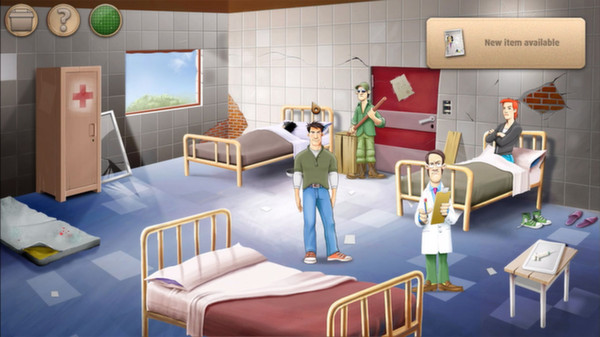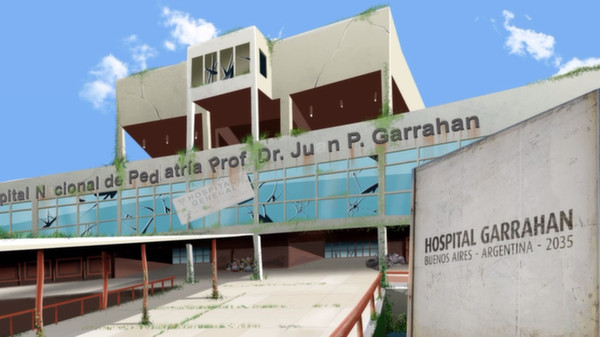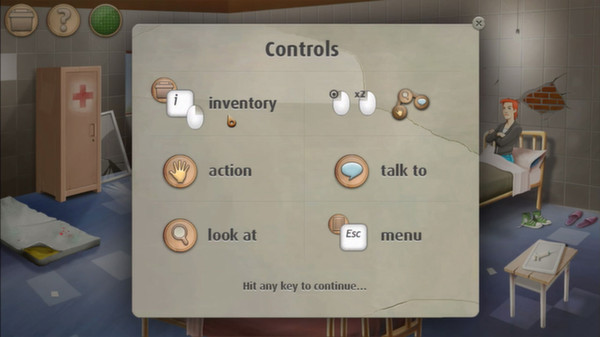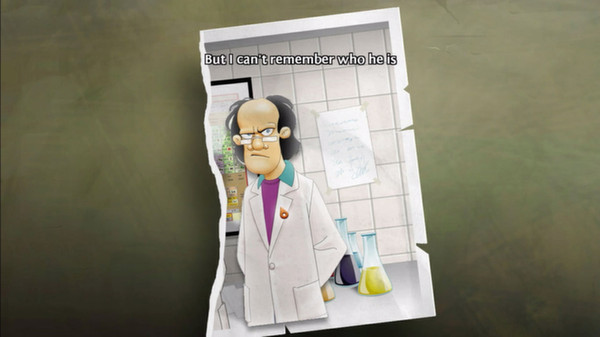Reversion – The Escape is the first chapter of a larger episodic point-and-click adventure developed and published by 3f Interactive, serving as both an introduction to its post-apocalyptic setting and an experiment in classic adventure storytelling. Set in a dystopian future version of Buenos Aires, the game begins with the protagonist awakening inside a guarded hospital with no memory of who he is or how he got there. The city outside has fallen under the control of a mysterious paramilitary regime, and his only immediate goal is survival. As he interacts with other captives and begins to piece together fragments of his identity, the player is drawn into a world of political intrigue, personal loss, and quiet resistance. The story’s framing evokes classic amnesia narratives, using the protagonist’s lack of memory as both a gameplay conceit and a narrative hook. While it is clear that this episode is primarily a prologue for a larger saga, it successfully plants the seeds of mystery that encourage players to continue through later installments. As a traditional point-and-click adventure, Reversion – The Escape adheres closely to the genre’s roots, focusing on puzzle-solving, dialogue, and environmental exploration. Each scene is carefully constructed as a self-contained puzzle space, requiring the player to examine objects, combine inventory items, and interact with other characters to progress. The puzzles are mostly grounded in logic—using a screwdriver to fix a machine or distracting a guard with a found item—avoiding the overly abstract solutions that often frustrate players in older adventure titles. There is a built-in hint system designed to guide players without making the answers too obvious, and it strikes a commendable balance between accessibility and challenge. The interface is intuitive, with clear icons for interaction, and the cursor changes contextually to show available actions. The pacing of the gameplay feels deliberate; it rewards careful observation and patience rather than reflexes or speed, aligning it more with the slow-burn storytelling traditions of games like Broken Sword or The Longest Journey. The game’s visual design carries much of its personality. The environments are hand-drawn in a cartoon-like style that contrasts with the grim tone of the story, giving it a distinctive charm despite limited animation. Each room is colored with warm tones that help convey atmosphere without relying on heavy detail. The hospital, for instance, feels claustrophobic yet visually clean, while outdoor scenes use desaturated hues to suggest a world drained of vitality. Character designs are simple but expressive enough to distinguish personalities, even if movement animations sometimes appear stiff or abrupt. The overall presentation is clean and functional, prioritizing clarity over spectacle. Despite technical modesty, there is care in how scenes are framed and transitions handled; the camera never distracts from the player’s focus on puzzle-solving. The music, while understated, complements the atmosphere effectively, shifting between quiet piano-driven melodies and tense background ambience. Voice acting is available in both English and Spanish, and while the performances vary in quality, they give the world a sense of authenticity and cultural grounding that text-only dialogue would have lacked. The narrative structure of Reversion – The Escape reflects its episodic nature. Most of the story is confined to a single location—the hospital—and the player’s interactions are limited to a handful of supporting characters. The dialogue system is straightforward, presenting a list of conversational options that help flesh out backstory or reveal puzzle hints. Through these exchanges, players gradually uncover the hints of a broader world beyond the hospital walls: the fall of Buenos Aires, the rise of an oppressive military force, and rumors of resistance groups trying to reclaim freedom. These narrative threads create a sense of intrigue and scope that the first episode itself only briefly touches on. By the time the player reaches the conclusion, which ends with the protagonists escaping the facility, it becomes evident that the game functions more as an introduction than a full story. Its abrupt ending can feel jarring, especially given that the game can be completed in less than an hour. However, as a pilot episode for a series, it succeeds in establishing tone and premise effectively enough to justify its brevity. Reversion’s greatest strength lies in its clarity of purpose. It doesn’t attempt to overwhelm players with unnecessary complexity or modern embellishments; instead, it channels the feel of classic adventure games, updated with smoother usability and a more approachable structure. The puzzles, while simple, are satisfying, and the narrative pacing ensures steady progression without major frustration. Where it falters is in its limited scope and production values. The voice acting can occasionally sound unpolished, some animations feel rough, and certain lines of dialogue lose nuance in translation. Moreover, because the episode is so short, it lacks the narrative depth or emotional payoff that would make it stand on its own. It feels like a promising introduction rather than a complete work, relying heavily on future chapters to deliver on its potential. For players familiar with traditional adventure games, Reversion – The Escape offers a brief but enjoyable return to the fundamentals of the genre. It captures the essence of classic storytelling—mystery, exploration, and discovery—while packaging it in a more accessible form for modern audiences. It won’t challenge veterans with difficult puzzles or complex dialogue trees, but it offers a well-paced and polished experience that respects players’ time. For newcomers, it provides a gentle introduction to the mechanics of point-and-click adventures without overwhelming them with obtuse logic or sprawling inventories. While it may be too short to fully satisfy on its own, it effectively sets the stage for the subsequent chapters of the Reversion trilogy, hinting at a world that is much larger and more complex than what this opening act reveals. Ultimately, Reversion – The Escape is a modest but sincere effort—a small, self-contained mystery that feels like the first step in a longer, more ambitious journey. Rating: 8/10
Expand the review
























